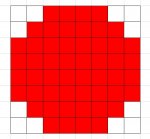It’s a square
By default, D&D 5e isn’t played on a grid, or other mapping—it’s simply played as imagined, the so-called “theater of the mind.” Since there is no mapping or geometric abstraction in play, a circle is simply a circle.
However, 5e does offer a “variant” style in which a grid is used, in which case it uses the same geometry that was used in D&D 4e—moving from one square to any adjacent square, including along diagonals, counts as 5 feet (or 1 square) of movement. It even recommends converting ranges, speeds, and so on to squares (by dividing by 5 feet/square), which is exactly what 4e did when this was the default.
In this geometry—mathematicians know it as Chebyshev distance or chessboard distance—a “circle” (read: the geometric figure formed of the set of points each at some fixed radius away from a central point) looks like a square. A sphere looks like a cube. This is its advantage, even though it looks weird—it’s really easy to calculate. Contrast that with this nonsense for D&D 3.5e, which used a “more accurate” approximation for diagonals by making them cost 1½× horizontal/vertical movement (reality would be \$\sqrt{2}\times \approx 1.414\times\$).
So moving in a “circle” around a target looks (to us) like moving in a square around them. That’s how you maintain a constant distance away from them (presumably outside their range and inside yours). There is no “difficult terrain” involved (only actual difficult terrain, things impeding your ability to move like brambles or water or whatever, should cause that). Diagonals don’t really come up when moving around a circle, but the shape of the circle is certainly dictated by how diagonals work.
Likewise, something with a 20-ft. radius produces a 40-ft × 40-ft square—that’s 160 feet around. Since you’re walking around the squares outside of that, though, it’s actually 180 feet, assuming you cut the corners.

